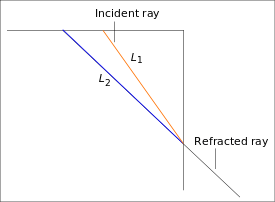Ibn Sahl


Ibn Sahl (Arabic: ابن سهل) (Abu Saʿd al-ʿAlaʾ ibn Sahl ) (Arabic: أبو سعد العلاء ابن سهل) (c. 940–1000) was a Persian[1][2] Muslim mathematician, physicist and optics engineer of the Islamic Golden Age associated with the Abbasid court of Baghdad. Ibn Sahl's 984[3] treatise On Burning Mirrors and Lenses sets out his understanding of how curved mirrors and lenses bend and focus light. Ibn Sahl is credited with first discovering the law of refraction, usually called Snell's law.[4][5] He used the law of refraction to derive lens shapes that focus light with no geometric aberrations, known as anaclastic lenses.
In the reproduction of the figure from Ibn Sahl's manuscript, the critical part is the right-angled triangle. The inner hypotenuse shows the path of an incident ray and the outer hypotenuse shows an extension of the path of the refracted ray if the incident ray met a crystal whose face is vertical at the point where the two hypotenuses intersect.[6] According to Roshdi Rashed,[5] an author and historian of medieval science and mathematics, the ratio of the length of the smaller hypotenuse to the larger is the reciprocal of the refractive index of the crystal.
The lower part of the figure shows a representation of a plano-convex lens (at the right) and its principal axis (the intersecting horizontal line). The curvature of the convex part of the lens brings all rays parallel to the horizontal axis (and approaching the lens from the right) to a focal point on the axis at the left.
In the remaining parts of the treatise, Ibn Sahl dealt with parabolic mirrors, ellipsoidal mirrors, biconvex lenses, and techniques for drawing hyperbolic arcs.
Ibn Sahl's treatise was used by Ibn al-Haitham (965–1039), one of the greatest scholars of optics. In modern times, Rashed found the text to have been dispersed in manuscripts in two different libraries, one in Teheran, and the other in Damascus. He reassembled the surviving portions, translated and published them.[7]
See also
References
- ↑ http://sciencelearn.org.nz/Contexts/Light-and-Sight/Timeline/984/Ibn-Sahl-and-refraction
- ↑ https://www.iggy.net/knowledge/science/content/ibn-sahl
- ↑ Zghal, Mourad; et al. (2007). "The first steps for learning optics: Ibn Sahl's, Al- Haytham's and Young's works on refraction as typical examples" (PDF). The Education and Training in Optics and Photonics Conference. International Commission for Optics: 3. Retrieved 20 June 2011.
- ↑ K. B. Wolf, "Geometry and dynamics in refracting systems", European Journal of Physics 16, p. 14-20, 1995.
- 1 2 R. Rashed, "A pioneer in anaclastics: Ibn Sahl on burning mirrors and lenses", Isis 81, p. 464–491, 1990.
- ↑ Kurt Bernardo Wolf, Geometric Optics on Phase Space, p. 9, Springer, 2004, ISBN 3-540-22039-9 online
- ↑ Rashed, R., Géométrie et dioptrique au Xe siècle: Ibn Sahl, al-Quhi et Ibn al-Haytham. Paris: Les Belles Lettres, 1993.
External links
- Berggren, Len (2007). "Ibn Sahl: Abū Saʿd al‐ʿAlāʾ ibn Sahl". In Thomas Hockey; et al. The Biographical Encyclopedia of Astronomers. New York: Springer. p. 567. ISBN 978-0-387-31022-0. (PDF version)
- The Miracle of Light – a UNESCO article on the history of optics
